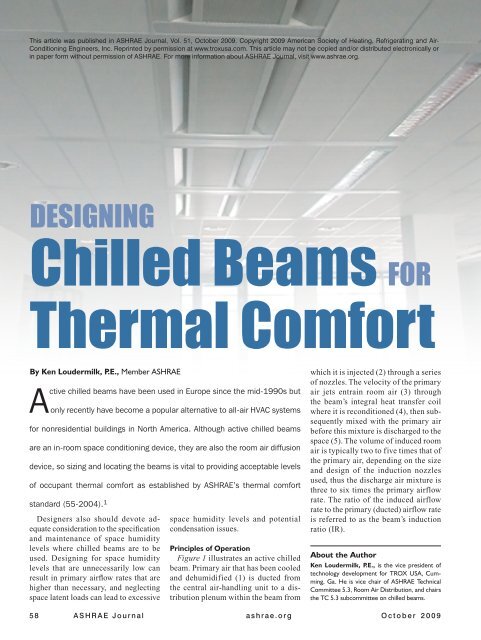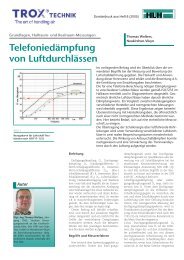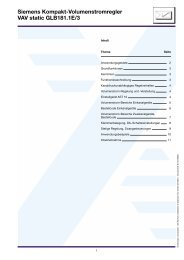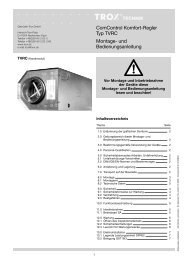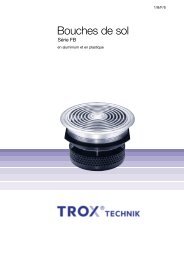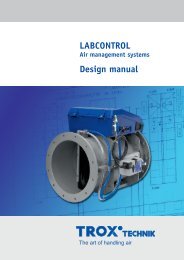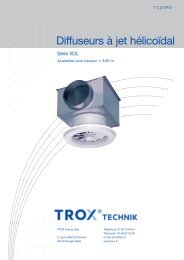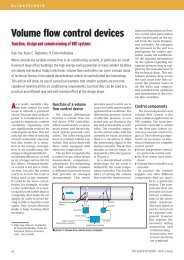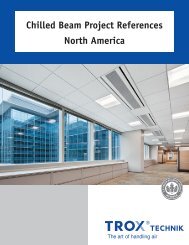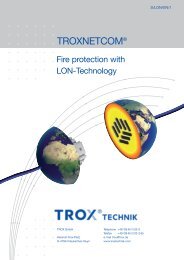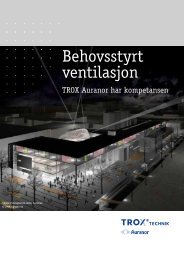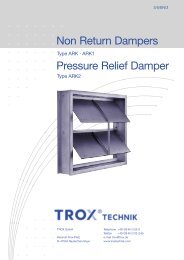ASHRAE Journal: Designing Chilled Beams for Thermal ... - TROX
ASHRAE Journal: Designing Chilled Beams for Thermal ... - TROX
ASHRAE Journal: Designing Chilled Beams for Thermal ... - TROX
Create successful ePaper yourself
Turn your PDF publications into a flip-book with our unique Google optimized e-Paper software.
This article was published in <strong>ASHRAE</strong> <strong>Journal</strong>, Vol. 51, October 2009. Copyright 2009 American Society of Heating, Refrigerating and Air-<br />
Conditioning Engineers, Inc. Reprinted by permission at www.troxusa.com. This article may not be copied and/or distributed electronically or<br />
in paper <strong>for</strong>m without permission of <strong>ASHRAE</strong>. For more in<strong>for</strong>mation about <strong>ASHRAE</strong> <strong>Journal</strong>, visit www.ashrae.org.<br />
DESIGNING<br />
<strong>Chilled</strong> <strong>Beams</strong><br />
FOR<br />
<strong>Thermal</strong> Com<strong>for</strong>t<br />
By Ken Loudermilk, P.E., Member <strong>ASHRAE</strong><br />
Active chilled beams have been used in Europe since the mid-1990s but<br />
only recently have become a popular alternative to all-air HVAC systems<br />
<strong>for</strong> nonresidential buildings in North America. Although active chilled beams<br />
are an in-room space conditioning device, they are also the room air diffusion<br />
device, so sizing and locating the beams is vital to providing acceptable levels<br />
of occupant thermal com<strong>for</strong>t as established by <strong>ASHRAE</strong>’s thermal com<strong>for</strong>t<br />
standard (55-2004). 1<br />
Designers also should devote adequate<br />
consideration to the specification<br />
and maintenance of space humidity<br />
levels where chilled beams are to be<br />
used. <strong>Designing</strong> <strong>for</strong> space humidity<br />
levels that are unnecessarily low can<br />
result in primary airflow rates that are<br />
higher than necessary, and neglecting<br />
space latent loads can lead to excessive<br />
space humidity levels and potential<br />
condensation issues.<br />
Principles of Operation<br />
Figure 1 illustrates an active chilled<br />
beam. Primary air that has been cooled<br />
and dehumidified (1) is ducted from<br />
the central air-handling unit to a distribution<br />
plenum within the beam from<br />
which it is injected (2) through a series<br />
of nozzles. The velocity of the primary<br />
air jets entrain room air (3) through<br />
the beam’s integral heat transfer coil<br />
where it is reconditioned (4), then subsequently<br />
mixed with the primary air<br />
be<strong>for</strong>e this mixture is discharged to the<br />
space (5). The volume of induced room<br />
air is typically two to five times that of<br />
the primary air, depending on the size<br />
and design of the induction nozzles<br />
used, thus the discharge air mixture is<br />
three to six times the primary airflow<br />
rate. The ratio of the induced airflow<br />
rate to the primary (ducted) airflow rate<br />
is referred to as the beam’s induction<br />
ratio (IR).<br />
About the Author<br />
Ken Loudermilk, P.E., is the vice president of<br />
technology development <strong>for</strong> <strong>TROX</strong> USA, Cumming,<br />
Ga. He is vice chair of <strong>ASHRAE</strong> Technical<br />
Committee 5.3, Room Air Distribution, and chairs<br />
the TC 5.3 subcommittee on chilled beams.<br />
5 8 A S H R A E J o u r n a l a s h r a e . o r g O c t o b e r 2 0 0 9
The sensible cooling coil within the beam is supplied with<br />
chilled water whose supply temperature is maintained at, or<br />
above, the space dew-point temperature to prevent condensation.<br />
The sensible heat removed by the coil typically constitutes<br />
50% to 75% of the required space sensible heat removal. As a<br />
result, the primary airflow rate required to accomplish the space<br />
sensible cooling can be reduced accordingly.<br />
Although primary (ducted) airflow rates associated with<br />
chilled beams are considerably lower than those in all-air systems,<br />
their discharge airflow rate to the room is always greater.<br />
Since the chilled water supplied to the beam is maintained<br />
above the space dew point, the beam’s off-coil temperature<br />
will be higher than the primary air temperatures used in all-air<br />
systems. The resultant temperature of the beam’s discharge<br />
mixture is typically 3°F to 6°F (2°C to 3.3°C) warmer than<br />
that of all-air systems. There<strong>for</strong>e, a proportionally higher<br />
(20% to 30%) discharge airflow rate to the space must be<br />
provided. This higher discharge flow rate often contributes to<br />
greater draft risks, which may compromise occupant thermal<br />
com<strong>for</strong>t levels.<br />
V L ’ T L<br />
1<br />
Beam A<br />
V O ’ T O<br />
Q S<br />
Q A Q A<br />
2<br />
4<br />
5<br />
3<br />
A<br />
Beam B<br />
V C<br />
V O ’ T O<br />
Q S<br />
H1<br />
V H1 ’ T H1<br />
<strong>Designing</strong> <strong>for</strong> Occupant <strong>Thermal</strong> Com<strong>for</strong>t<br />
Standard 55-2004 2 defines the occupied zone as the portion of<br />
a space where occupants normally reside. It is further quantified<br />
as the volume of the room that is (1) no closer than 3.3 ft (1 m)<br />
from any outside walls or windows nor within 1 ft (0.3 m) of<br />
any internal wall and (2) is vertically bounded by the floor and<br />
the head level of the predominant space occupants. Although<br />
the head level is often accepted to be 67 in. (1.7 m) <strong>for</strong> standing<br />
occupants, the standard allows the designer to define that<br />
height according to the space occupancy.<br />
For example, if a space is predominantly occupied by seated<br />
persons, the occupied zone height could be considered as 42 in.<br />
(1.1 m). Chapter 20 of the 2007 <strong>ASHRAE</strong> Handbook— HVAC<br />
Applications 3 predicts the percentage of occupants who might<br />
express thermal dissatisfaction <strong>for</strong> various combinations of<br />
local air speed and temperatures. Figure 2 (from that chapter)<br />
can be used to predict the percentage of occupants that will<br />
object to various air speeds and temperatures at the neck and<br />
ankle regions. As active chilled beams are normally mounted<br />
overhead, the neck region is usually the most critical. Com<strong>for</strong>t<br />
cooling applications should strive to minimize dissatisfaction<br />
levels, and in all cases limit the percentage of occupants objecting<br />
to these local conditions to 20% or less.<br />
Room Air Distribution<br />
Active chilled beams distribute air within the room in a<br />
manner consistent with that of linear slot diffusers. As such,<br />
relationships between airstream terminal velocities and thermal<br />
decay of the supply airstream that apply to linear slot diffusers<br />
also apply to active chilled beams. Upon discharge to the open<br />
space, velocity and temperature differentials between the supply<br />
air mixture and the room begin to diminish due to room air<br />
entrainment. Linear slot diffusers exhibit relatively long throw<br />
characteristics and their velocity and temperature differentials<br />
1 m<br />
(0.3 ft)<br />
Occupied Zone<br />
(Height Determined By Designer)<br />
Figure 1: Application of active chilled beams.<br />
diminish at a rate that is proportional to the distance the air has<br />
traveled within the space.<br />
Manufacturers publish throw values that allow designers to<br />
estimate the travel distance of the airstream be<strong>for</strong>e it reaches a<br />
given terminal velocity. Most manufacturers present such data<br />
using isothermal air <strong>for</strong> terminal velocities of 150, 100 and 50<br />
fpm (0.75, 0.5 and 0.25 m/s). These data can be used to map<br />
the airstream and predict the local velocity at the point where it<br />
enters the occupied zone. As the room-to-supply-air-differential<br />
decays at a similar rate, its temperature also can be predicted<br />
at the entry point based on the initial temperature difference<br />
(ΔT O ) between the beam discharge temperature and that of the<br />
room into which it is introduced. Manufacturers supply selection<br />
software that can be used predict the value of local velocities<br />
and temperatures at critical locations such as that where the<br />
airstream enters the occupied zone.<br />
Figure 1 illustrates a space being served by two active beams<br />
with two-way discharge patterns delivering identical primary<br />
(Q P ) and discharge (Q S ) airflow rates. The discharge airflow<br />
rate is a function of the induction ratio of the nozzles chosen<br />
and is calculated by multiplying the primary airflow rate by the<br />
induction ratio. Assume a beam produces an induction ratio of<br />
2.5 and is sized to deliver 100 cfm (170 m 3 /h) of 55°F (13°C)<br />
primary air to a 75°F (24°C) room. Also, assume that chilled<br />
water enters the beam at 57°F (14°C) and leaves at 61°F (16°C).<br />
The discharge airflow rate to the space will be 3.5 times the<br />
O c t o b e r 2 0 0 9 A S H R A E J o u r n a l 5 9
primary airflow rate or 350 cfm (595 m 3 /h). The temperature<br />
(T OC ) of the air leaving the beam’s integral cooling coil can<br />
be conservatively estimated as 1°F (0.6°C) warmer than its<br />
mean chilled water temperature, which is the average of the<br />
entering and leaving chilled water temperatures. In fact, the<br />
leaving air temperature would typically be at least 2°F to 4°F<br />
(1°C to 2°C) higher than the coil mean water temperature. The<br />
beam manufacturer has this in<strong>for</strong>mation as well as the beam’s<br />
IR. Upon identifying the primary air temperature (T PA ), the<br />
temperature (T Z ) leaving the beam as well as the initial room<br />
to supply air temperature difference (ΔT Z ) can be estimated<br />
using Equations 1 and 2.<br />
T Z = [T PA + (T OC × IR)] / (IR+1) (1)<br />
or, <strong>for</strong> this example,<br />
ΔT Z = T ROOM – T Z (2)<br />
T Z = [55°F + (60°F × 2.5)] / (2.5 + 1) = 58.6°F and<br />
ΔT Z = 75°F – 58.6°F = 16.4°F<br />
The initial velocity (V O ) of a supply airstream leaving the<br />
discharge slot can be calculated by dividing the supply airflow<br />
rate leaving each slot (<strong>for</strong> two-way beams this is 0.5 x Q S ) by the<br />
effective area of that slot. If the effective area is not available,<br />
V O can be conservatively estimated as 450 fpm (2.3 m/s) <strong>for</strong> the<br />
purposes of this calculation. The local temperature difference<br />
(ΔT X ) between the room and the supply airstream at any point<br />
along its travel can be estimated by Equation 3. 4<br />
ΔT X = 0.8 × ΔT Z × (V X / V O ) (3)<br />
For a beam with an initial discharge velocity (V O ) of 450 fpm<br />
(2.3 m/s) and an initial supply to room temperature differential<br />
(ΔT Z ) of 16.4°F (9.1°C), the local temperature differential (ΔT X )<br />
at the point coincident with a 50 fpm (0.25 m/s) terminal velocity<br />
is about 1.4°F (0.9°C). Referring to Figure 2, this predicts<br />
that less than 20% of the occupants would be dissatisfied with<br />
these local velocity/temperature conditions.<br />
As the region near the outside walls is not defined as part<br />
of the occupied zone, local velocities and temperatures do not<br />
generally affect occupant thermal com<strong>for</strong>t. Care should still be<br />
taken that they are not so high that they can affect processes<br />
(e.g., fume hoods) along the outer wall and that they are sufficient<br />
to provide adequate heating where applicable. Chapter 56<br />
of the 2007 <strong>ASHRAE</strong> Handbook—HVAC Applications 5 recommends<br />
that outlets used <strong>for</strong> perimeter heating be selected and<br />
located such that their isothermal throw to 150 fpm (0.75 m/s)<br />
extends at least halfway down the outside surface or to a level<br />
5 ft (1.5 m) above the floor, whichever is greater.<br />
The area of greatest draft risk usually occurs directly below<br />
the point where two opposing airstreams collide. Figure 1 illustrates<br />
such a point and defines the collision velocity as V C .<br />
If the velocity (V C ) of the colliding airstreams is of sufficient<br />
velocity (greater than 100 fpm or 0.5 m/s), some of the velocity<br />
and temperature differential of the airstreams is dissipated by the<br />
collision and the velocity (V H1 ) at the point where the airstream<br />
Figure 2: Percentage of occupants objecting to drafts in air. 3<br />
enters the occupied zone is reduced accordingly. Figure 3 can<br />
be used to estimate the velocity at the entry point <strong>for</strong> various<br />
collision velocities and vertical distances (H1) between the<br />
point of collision and the top of the occupied zone. This figure<br />
illustrates that the velocity (V H1 ) entering the occupied zone<br />
directly below the point of collision of two airstreams will be<br />
less than half the collision velocity (V C ) if distance H1 (the<br />
distance between the ceiling and the top of the designated occupied<br />
zone) is greater than or equal to 3.5 ft (1.1 m).<br />
In cases where the collision velocity (V C ) is 100 fpm (0.5 m/s)<br />
V H1 would be less than or equal to 50 fpm provided H1 is greater<br />
than 3.5 ft (1.1 m). In cases where H1 is greater than 3.5 ft (1.1<br />
m), active chilled beams should be sized and located so that<br />
their throw to a terminal velocity of 100 fpm (0.5 m/s) does not<br />
exceed half the distance to another beam with an opposing blow.<br />
In cases where the collision velocity (V C ) is 150 fpm (0.75<br />
m/s), V H1 is less than or equal to 50 fpm provided H1 is greater<br />
than 6 ft (1.8 m). Active beams <strong>for</strong> which H1 is greater than<br />
6 0 A S H R A E J o u r n a l a s h r a e . o r g O c t o b e r 2 0 0 9
or equal to 6 ft (1.8 m) can be sized such that their throw to a<br />
terminal velocity of 150 fpm (0.75 m/s) does not exceed half<br />
the distance to a beam with an opposing discharge.<br />
Figure 3 can be used to determine the maximum collision<br />
velocity that limits velocities within the occupied zone to 50<br />
fpm (0.25 m/s) or less <strong>for</strong> any given distance H1 using the following<br />
equation:<br />
V C = 50 / (V H1 / V C ) (4)<br />
where V H1 / V C is the value from Figure 3 that corresponds to<br />
the distance H1.<br />
For example, if H1 is equal to 4 ft,<br />
V C = 50 / 0.43 = 116 fpm<br />
Room Humidity Design Considerations<br />
The sensible cooling contribution with chilled beams af<strong>for</strong>ds<br />
the designer an opportunity to significantly reduce the<br />
primary airflow rate compared to all air systems. As 50% to<br />
75% of the sensible heat gains are typically removed by the<br />
chilled water coil, proportional reductions in the primary<br />
airflow rates within the system may be achievable. However,<br />
this should be done with caution as the beam must also deliver<br />
sufficient ventilation air and maintain acceptable space<br />
humidity levels. The primary airflow rate to the room must<br />
be the greater of that required to (1) ventilate the space in<br />
con<strong>for</strong>mance to <strong>ASHRAE</strong> Standard 62.1-2007 6 (or other<br />
applicable ventilation codes); (2) offset space latent gains<br />
to control the room humidity level within <strong>ASHRAE</strong> Standard<br />
55-2004 recommendations; and (3) provide sufficient<br />
sensible cooling to complement the sensible heat removed<br />
by the chilled water coil.<br />
In most common interior space applications, the primary<br />
airflow rate required to offset space latent gains will exceed<br />
both the ventilation airflow rate and the airflow rate required<br />
to complement the coil’s sensible cooling. The space airflow<br />
rate will be determined by the latent gains and the design<br />
room humidity ratio (W ROOM ). In perimeter spaces, the<br />
primary airflow rate to the beams will be driven by the sensible<br />
load (laboratories may be exceptions due to their high<br />
mandated ventilation rates). The use of beams whose water<br />
side cooling capacity contributes to more than about 65%<br />
of the total space load may be impractical due to architectural<br />
constraints that limit the installed beam quantities and<br />
lengths in these spaces. The goal of the design should be to<br />
reduce the primary airflow rate to as close to the required<br />
ventilation rate as possible.<br />
<strong>Designing</strong> chilled beam systems to maintain room air humidity<br />
levels lower than necessary can result in considerably<br />
higher primary air requirements. Figure 4 is presented in<br />
Standard 55-2004 7 and prescribes acceptable ranges of room<br />
temperatures and humidity ratios. Assuming a clothing level<br />
of 1.0 clo (0.15 m 2 · k/W), this diagram defines the thermal<br />
com<strong>for</strong>t window <strong>for</strong> a dry-bulb temperature of 75°F (24°C)<br />
to include room dew-point temperatures as high as 62°F<br />
Distance H1 (ft)<br />
7.0<br />
6.5<br />
6.0<br />
5.5<br />
5.0<br />
4.5<br />
4.0<br />
3.5<br />
3.0<br />
2.5<br />
0.3 0.4 0.5 0.6 0.7<br />
V H1 /V C<br />
Figure 3: Velocities entering the occupied zone.<br />
Figure 4: <strong>ASHRAE</strong> Summer and Winter Com<strong>for</strong>t Zones. Acceptable<br />
ranges of operative temperature and humidity with air speed ≤ 40<br />
fpm (≤0.20 m/s) <strong>for</strong> people wearing 1.0 and 0.5 clo (0.15 m 2 · k/W<br />
and 0.08 m 2 · k/W) clothing during primarily sedentary activity<br />
(≤1.1 met [≤63.9 W/m 2 ]). 8<br />
(16.7°C). Where chilled beams are applied, the room dewpoint<br />
temperature must not exceed the chilled water supply<br />
temperature, so design <strong>for</strong> dew points above about 57°F (14°C)<br />
is not recommended.<br />
Most conventional HVAC systems condition delivered air to<br />
about a 52°F (11°C) dew-point temperature, which coincides<br />
with a humidity ratio (W PRIMARY ) of 58 grains (3.8 g). The<br />
airflow rate (Q PRIMARY ) to offset the space latent heat gains<br />
(q LATENT ) can be determined by Equation 5.<br />
Q PRIMARY = q LATENT / [0.68 × (W ROOM – W PRIMARY )] (5)<br />
Using this equation and assuming the humidity ratio of the<br />
primary air is 58 grains (3.8 g), the primary airflow requirement<br />
6 2 A S H R A E J o u r n a l a s h r a e . o r g O c t o b e r 2 0 0 9
<strong>for</strong> a space whose latent gains total 400 Btu/h (117 W) can be<br />
calculated <strong>for</strong> various design humidity ratios:<br />
If W R OOM = 65 grains (50% RH) → Q PRIMARY = 84 cfm<br />
If W R OOM = 68 grains (52% RH) → Q PRIMARY = 59 cfm<br />
If W R OOM = 69 grains (53% RH) → Q PRIMARY = 53 cfm<br />
In this case, designing <strong>for</strong> 75°F (24°C) and 50% relative<br />
humidity would result in a primary airflow rate that is 58%<br />
higher than that required to maintain 53% RH in the space. As<br />
the 53% RH is within Standard 55-2004 recommendations and<br />
results in a space dew-point temperature of 57°F (14°C), it is<br />
probably a reasonable design goal.<br />
<strong>Chilled</strong> beams are often used with central HVAC equipment<br />
that includes heat recovery and enthalpy wheels. Lower space<br />
dew-point temperatures can be achieved when the dew-point<br />
temperature is further suppressed by these processes. In cases<br />
where room dew-point temperatures below 55°F (13°C) are<br />
desired, using such equipment is recommended.<br />
Summary<br />
Active chilled beams can be selected to remove large amounts<br />
of sensible heat while substantially reducing primary airflow<br />
requirements. However, this must be done with consideration<br />
Advertisement <strong>for</strong>merly in this space.<br />
of the occupant thermal com<strong>for</strong>t and space dehumidification.<br />
Because producing high levels of thermal com<strong>for</strong>t is the primary<br />
objective of any com<strong>for</strong>t cooling application, beams should be<br />
selected, sized and located with that in mind.<br />
While primary airflow reduction opportunities are an inherent<br />
characteristic of chilled beams, the reduction of such should<br />
be limited to that required to provide adequate space humidity<br />
control. All-air systems almost always deliver a sufficient<br />
amount of dry air to satisfy the space sensible load, there<strong>for</strong>e,<br />
engineers often do not consider space latent loads in their selection.<br />
Individual space latent loads should be considered when<br />
designing chilled beam systems.<br />
In conclusion, the following design guidelines should be observed<br />
when selecting, sizing and locating active chilled beams:<br />
• <strong>Chilled</strong> beams should not be used in low ceiling<br />
height applications where the distance between the<br />
ceiling and the top of the occupied zone is less than<br />
3 ft (0.9 m).<br />
• When applied in lobbies, atriums or other areas with<br />
high and/or uncontrollable infiltration rates, provide<br />
adequate condensation prevention strategies.<br />
• To maintain high levels of thermal com<strong>for</strong>t (velocities<br />
within the occupied zone no greater than 50 fpm<br />
or [0.25 m/s]), active chilled beams were mounted<br />
at least 3.5 ft (1.1 m) above the designated occupied<br />
zone should be sized and located such that their throw<br />
to a terminal velocity of 100 fpm (0.5 m/s) does not<br />
exceed half the distance between them and another<br />
beam with an opposing blow. Active beams mounted<br />
6 ft (2 m)or more above the designated occupied zone<br />
may be located such that their throw to a terminal<br />
velocity of 150 fpm (0.75 m/s) is as much as half the<br />
distance between the beam and an adjacent beam with<br />
an opposing discharge.<br />
• Smaller nozzles result in higher induction ratios and<br />
higher sensible cooling capacities per cfm (m 3 /h) of<br />
primary air. However, the use of smaller nozzles generally<br />
results in higher noise levels and inlet pressure<br />
requirements <strong>for</strong> a given primary airflow rate that<br />
increases the number of beams required.<br />
• <strong>Designing</strong> <strong>for</strong> space humidity levels lower than that<br />
actually required may result in significantly higher<br />
primary airflow rates.<br />
References<br />
1. ANSI/<strong>ASHRAE</strong> Standard 55-2004, <strong>Thermal</strong> Environmental<br />
Conditions <strong>for</strong> Human Occupancy.<br />
2. Standard 55-2004, p. 3.<br />
3. 2009 <strong>ASHRAE</strong> Handbook—Fundamentals, p. 20.13.<br />
4. Koestal, A. 1954. “Computing temperature and velocities in<br />
vertical jets of hot or cold air.” ASHVE Transactions 60:385.<br />
5. 2007 <strong>ASHRAE</strong> Handbook—HVAC Applications, p. 56.4.<br />
6. ANSI/<strong>ASHRAE</strong> Standard 62.1-2004, Ventilation <strong>for</strong> Acceptable<br />
Indoor Air Quality, Table 6-1.<br />
7. Standard 55-2004, p. 5.2.1.1.<br />
8. 2009 <strong>ASHRAE</strong> Handbook—Fundamentals, p. 9.12.<br />
6 4 A S H R A E J o u r n a l O c t o b e r 2 0 0 9


